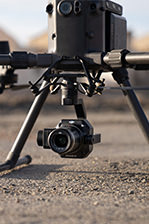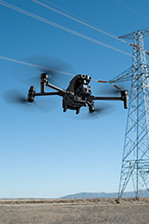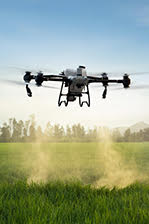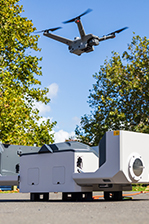DJI RS 4 Pro Combo
The DJI RS 4 Pro expansive flagship stabiliser integrates seamlessly with the DJI Focus Pro lens control system, DJI Transmission, and an extensive control ecosystem. This synergy empowers the film and television industry with a full-scale production solution that unites stabilisation, transmission, monitoring, focusing, and control. It broadens the horizons of creative possibilities, enabling cinematographers to harness their full potential and showcase their skills.

Packed With Capabilities
Powerful Payload
Equipped with carbon fibre axis arms, DJI RS 4 Pro boasts a 4.5kg (10lbs) payload capacity as well as robust power and torque, easily accommodating mainstream mirrorless/cinema camera and lens setups.
2nd-Gen Native Vertical Shooting
Designed with an all-new horizontal plate, RS 4 Pro enables the second generation of native vertical shooting for further elevated efficiency. Without the need for additional accessories, cinematographers can simply release the horizontal plate and secure it into the vertical position for an effortless switch to vertical shooting. [1]
Smooth Balancing
The roll axis now has dual rolling bearings, facilitating easier adjustments.
All three axes feature a Teflon™ coating with a low friction coefficient, ensuring smooth balancing even when mounting heavy cameras.
When switching cameras or lenses, a fine-tuning knob on the tilt axis allows you to move the camera forward or backward, achieving precise, millimetre-level balancing.
The upper quick-release plate has added an adjustable placement guide to prevent the camera from loosening or shifting.
Automatic Screen Lock
The OLED touchscreen incorporates a new auto-lock feature, preventing accidental touches during shooting. When the screen is locked, it can still display the current gimbal and joystick modes at a low brightness, reducing power consumption.
2nd-Gen Automated Axis Locks
With the next-generation automated axis locks, DJI RS 4 Pro can quickly start working or enter sleep mode, significantly enhancing shooting, transition, and storage efficiency. In addition, the axis locks have been upgraded to achieve smaller gaps, further reducing gimbal shakes when locked.
| Ranging Points | Max Focus Distance [6] | FOV | LiDAR Refresh Rate |
|---|---|---|---|
| 76,800 | 20 m | 70° | 30 Hz |
| A leap of 77%, [5] sharpening human subject edge detection while effectively reducing focus hunting. | The human-subject focus distance is approximately three times that of the previous generation, [5] effortlessly handling long-distance focusing with telephoto lenses. | Beneficial for edge compositions and close-up shots, providing a larger framing space. | Focus on moving subjects with confidence with faster subject information collection and the enhanced speed of the Focus Pro Motor. [4] |
Next-Gen ActiveTrack Pro
Leveraging the all-new Focus Pro LiDAR [3] and AI algorithms, the next-gen ActiveTrack Pro enables RS 4 Pro's three-axis gimbal to steadfastly track your subject. Even if the subject is briefly obscured, it can quickly relocate and retain focus. ActiveTrack Pro also exhibits excellent recognition and tracking performance in scenarios involving multiple subjects or when the subject is at a distance.
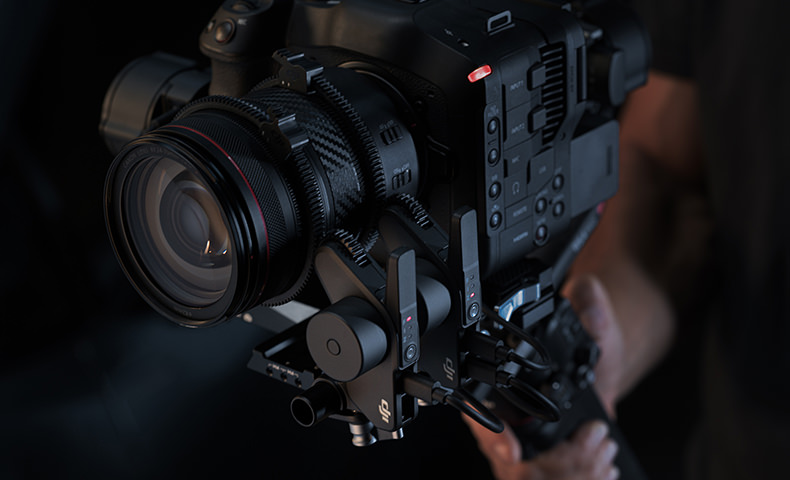
Dual Focus & Zoom Motors for Elevated Performance
DJI Focus Pro Motor
DJI RS 4 Pro introduces a new joystick mode switch, allowing cinematographers to control either the gimbal movement or the lens zoom via joystick. When used with the Focus Pro Motor [4] in zoom control mode, it can perform Power Zoom for PZ lenses, Clear Image Zoom, [7] and external focus motor zoom for a native, precise, and convenient focusing experience.
| Motor Speed [5] | Universal Rod | Lowest Latency [8] |
|---|---|---|
| Increased by 30% | 20 m | 10 ms |
| More responsive focus, zoom, and aperture controls. | More mainstream and versatile. | Rapid response for seamless operation. |
High-Efficiency Lens Control
When paired with two Focus Pro Motors, [4] DJI RS 4 Pro allows cinematographers to precisely control the focus by rotating the dial and adjusting the lens zoom via joystick, facilitating smooth and effortless lens control.
Remote Control System for Professional Collaboration
DJI Focus Pro Hand Unit
DJI Focus Pro ushers in innovative LiDAR autofocus technology and introduces a high-precision magnetic-damping manual control unit: Focus Pro Hand Unit. [3]
| Control Channels | Communication Distance | Electronic Marking | Bluetooth Functionality |
|---|---|---|---|
| FIZ | 160 m | A-B Points | Start/Stop Recording |
| Supports FIZ control, mastering the power of focus, iris, and zoom with ease. | Supports vehicle shoots and long-distance one-takes, etc. | Provides spring-back tactile feedback for endpoints, facilitating more accurate focusing on a fixed path or two subjects in static positions. | Enables remote start/stop recording of the camera, [7] improving shooting efficiency with cable cams, jibs, and other carriers. |
In collaborative team shooting, the gimbal operator can control the RS 4 Pro gimbal through devices such as DJI Master Wheels, DJI Ronin 4D Hand Grips, and DJI High-Bright Remote Monitor. [3] The focus puller can also enable LiDAR Waveform on the High-Bright Remote Monitor for intelligent focus assistance [9] to enable more precise control with the Focus Pro Hand Unit.
Efficient Operation, Flexible Creation
| Bluetooth Wireless Control | Trigger Function Customisation | Gimbal Mode Switch | Intelligent Features |
|---|---|---|---|
| DJI RS 4 Pro adopts Dual-Mode Bluetooth technology and supports wireless shutter and wireless zoom control. After switching joystick mode to zoom control, cinematographers can use the joystick to perform Power Zoom for PZ lenses as well as Clear Image Zoom. [7] | The trigger function can be customised to FPV mode, where pressing and holding the trigger makes the gimbal's three axes follow the direction of the grip's movement. This is particularly useful for shooting rotational footage or simulating POV. | Toggle to instantly switch the gimbal mode between PF, PTF, and FPV. You can also replace FPV mode with 3D Roll 360 mode or Custom mode based on your preference and shooting requirements, ensuring a seamless operation. | RS 4 Pro can automatically capture Motionlapse footage, Track videos, and Panorama images, intelligently producing high-quality short videos. |
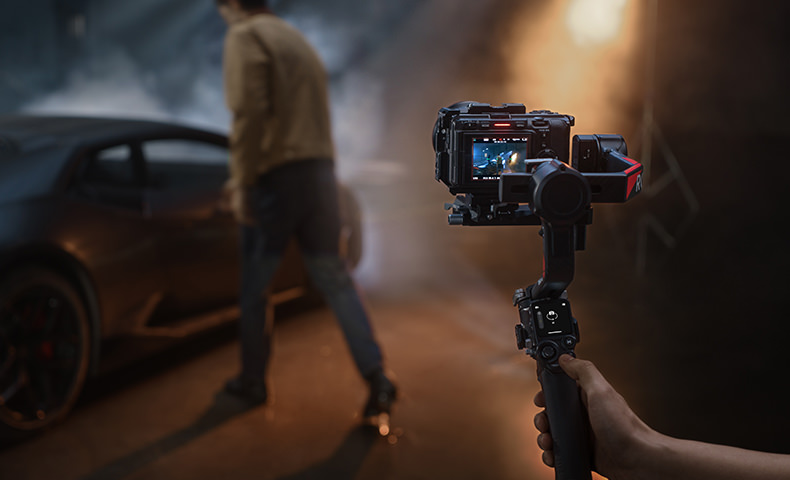
Exceptional Performance, Extended Battery Runtime
High-Capacity Battery Grip
Keep filming–with the DJI RS BG70 High-Capacity Battery Grip [3] extend RS 4 Pro's battery runtime to 29 hours. [10] It also supports powering your camera and accessories with up to 18 W via the USB-C port at the bottom.
| Max Battery Runtime [10] | PD Fast Charging | Rapid Full Charge[11] | Max Power Output |
|---|---|---|---|
| 29 Hours | 45 W | 2.5 Hours | 18 W |
Control Ecosystem, Enhanced Lineup
With the Focus Pro AMF lens control system seamlessly integrated, the DJI PRO ecosystem has been elevated further to offer a robust lineup that opens up new possibilities in film and television production.
Focus Control Ecosystem
DJI Focus Pro provides a comprehensive and powerful lens control solution to RS 4 Pro cinematographers. Both solo creations and team collaborations can easily access intelligent LiDAR autofocus as well as multi-channel control of focus, aperture, and zoom, for dynamic mastery over every focus moment.
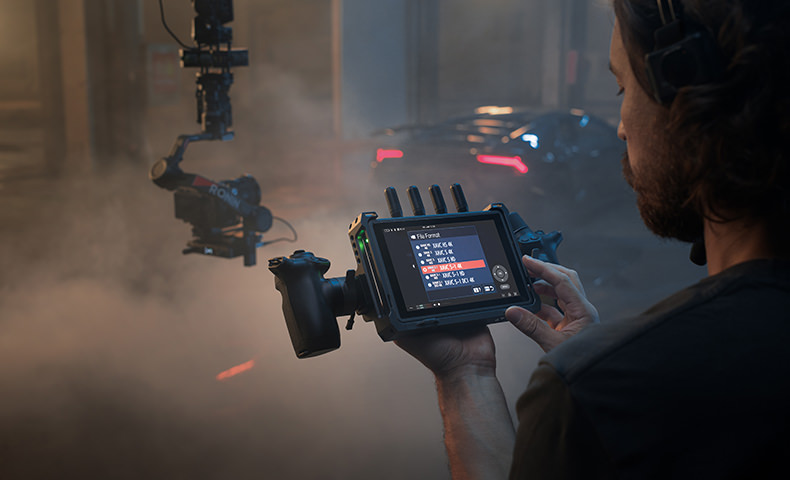
Video Transmission Ecosystem
Support for DJI Transmission
| Integrated Installation and Power Supply | Intelligent Focus Assistance | Gimbal / Focus / Camera Parameter Control | Mirror Control Mode |
|---|---|---|---|
| DJI RS 4 Pro can power the Focus Pro LiDAR [3] and DJI Video Transmitter [3] simultaneously via the Focus Pro LiDAR to DJI Transmission Cable Hub, [3] eliminating the need for an external V-mount battery. The DJI Video Transmitter can also be easily and directly mounted on the bottom of RS 4 Pro via the cold shoe for easy installation, reducing the burden for handheld setup. | With the Ronin 4D Hand Grips [3] and High-Bright Remote Monitor, [3] you can select LiDAR focus subjects, switch focus modes, and enable LiDAR Waveform. [9] | In conjunction with the Ronin 4D Hand Grips, [3] Focus Pro Hand Unit, [3] Master Wheels, [3] and High-Bright Remote Monitor, [3] you can remotely control the gimbal, focus, and camera parameters, achieving an integrated creative process that encompasses reception, monitoring, and control. | When RS 4 Pro is mounted to carriers like a jib, cable cam, or vehicle suction cup mount, you can directly control the core menu operations for Sony and other mirrorless cameras via Mirror Control mode on the High-Bright Remote Monitor, [3] without having to detach your camera. |
Support for DJI Ronin Image Transmitter
Both solo cinematographers and small crews can utilise the Ronin Image Transmitter [3] for high-definition live feeds, remote gimbal and camera control, ActiveTrack 4.0, Force Mobile, and many other features, achieving an integrated shooting experience with monitoring and control capabilities.
Professional Solutions
DJI RS 4 Pro supports various handheld configurations, including briefcase, dual-grip, and ring-mount setups. [12] Additionally, it can use DJI RS SDK protocol to establish solutions with car mounts, jibs, Steadicam, cable cams, and sliders, [12] meeting full-scenario creative needs.
DJI RS SDK creates a joint ecosystem with developers
DJI RS SDK is a developer protocol provided by DJI for developers and third-party hardware manufacturers to equip stabilisers such as RS 4 Pro, RS 3 Pro, and RS 4 with more features for extensive scenarios.
Features
Set gimbal position
Control gimbal rotation
Get motor and attitude information
Control camera focus and shooting
Applications
1. Build a virtual studio system that can use a PC or console to control the RS stabiliser. It also supports online control of multiple gimbals, allowing solo operators to manage several devices with ease.
2. Mount the RS stabiliser on a slider and link the two through programming for four-dimensional control. You can customise the shooting track to get effortlessly expressive camera movements.
Note: DJI RS SDK is currently available only in English and Chinese. If you have requests or questions, please visit the DJI Forum for more details.
| Solo Creations, Double the Efficiency | Professional Vehicle Shoots, All in One Go | Diverse Mounting, Boundless Creativity |
|---|---|---|
| When paired with Focus Pro, RS 4 Pro allows solo cinematographers to experience more accurate, distant, and intelligent LiDAR autofocus, gaining precise control over the cinematic expression in dynamic shooting scenarios. | With the DJI PRO ecosystem's lightweight vehicle-shooting solution, cinematographers can revel in a seamlessly integrated experience of stabilisation, monitoring, and dual-channel control of the gimbal and focus. | Based on RS SDK protocol, third-party manufacturers and individual developers can create customised solutions for RS 4 Pro, assisting cinematographers to effortlessly complete complex shoots with a jib, Steadicam, cable cam, or slider. |
| DJI RS 4 Pro, DJI Focus Pro LiDAR, DJI Focus Pro Motor | DJI RS 4 Pro, DJI Focus Pro LiDAR, DJI Focus Pro Motor, DJI Transmission (High-Bright Monitor Combo), DJI Ronin 4D Hand Grips Combo, DJI Focus Pro LiDAR to DJI Transmission Cable Hub, DJI Ronin External GPS Module | DJI RS 4 Pro, DJI Focus Pro LiDAR (Optional), DJI Focus Pro Motor, DJI Focus Pro Hand Unit, DJI Focus Pro LiDAR to DJI Transmission Cable Hub (Optional), DJI Transmission, DJI Master Wheels |
Notes:
* The DJI Ronin app is required for activation when using DJI RS 4 Pro for the first time.
1. The gimbal requires rebalancing after switching between horizontal and vertical shooting.
2. Compared with DJI RS 3 Pro.
3. Sold separately.
4. The DJI RS 4 Pro Combo includes a DJI Focus Pro Motor. For the standalone version, the motor is sold separately.
5. Compared with the DJI LiDAR Range Finder (RS).
6. Requires enabling the 2x zoom display function on the DJI RS 4 Pro touchscreen.
7. For more details on camera and lens compatibility, please refer to the Ronin Series Compatibility Search page.
8. This value indicates the response latency between the DJI Focus Pro Hand Unit and the DJI Focus Pro Motor.
9. LiDAR Waveform is only available when DJI RS 4 Pro is paired with a DJI Focus Pro Motor.
10. Measured in a 25° C (77° F) indoor environment with the gimbal balanced in a level and stationary state until the battery level reached 3% (with the battery grip only powering the gimbal).
11. Measured in a 25° C (77° F) indoor environment.
12. Setting up any of the shooting solutions requires one or more accessories that are sold separately.
Product Specifications
Peripheral
Accessory Port: Ronin Series Accessories (RSA)/NATO Ports
1/4"-20 Mounting Hole
Cold Shoe
Video Transmission/LiDAR Range Finder Port (USB-C)
RSS Camera Control Port (USB-C)
Focus Motor Port (USB-C)
Battery: Model: BG30-1950mAh-15.4V
Type: LiPo 4S
Capacity: 1950 mAh
Energy: 30 Wh
Max Runtime: 13 hours (Measured with the gimbal balanced in a level and stationary state. When the gimbal is in motion, the operating time will be reduced.)
Charging Time: Approx. 1.5 hours (Measured with a charger supporting 24W fast charging. It is recommended to use chargers supporting QC 2.0 or PD protocols.)
Suggested Charging Temperature: 5° to 40° C (41° to 104° F)
Connections: Bluetooth 5.1
Charging Port (USB-C)
Ronin App Requirements: iOS 11.0 or above
Android 8.0 or above
Languages Supported by the Touchscreen: English, Simplified Chinese, Traditional Chinese, German, French, Korean, Japanese, Spanish, Portuguese (Brazil), Russian, Thai
Working Performance
Tested Payload: 4.5 kg (10 lbs)
Maximum Controlled Rotation Speed: Pan: 360°/s
Tilt: 360°/s
Roll: 360°/s
Mechanical Range: Pan Axis: 360° continuous rotation
Roll Axis: -95° to +240°
Tilt Axis: -112° to +214°
Mechanical & Electrical Properties
Operating Frequency: 2.400-2.4835 GHz
Bluetooth Transmitter Power: < 8 dBm
Operating Temperature: -20° to 45° C (-4° to 113° F)
Weight: Gimbal: Approx. 1242 g (2.74 lbs)
Grip: Approx. 265 g (0.58 lbs)
Extended Grip/Tripod (Metal): Approx. 226 g (0.49 lbs)
Upper and Lower Quick-Release Plates: Approx. 110 g (0.24 lbs)
Dimensions: Folded: 271×283×75 mm (L×W×H, excluding camera, grip, and the Extended Grip/Tripod)
Unfolded: 416×223×202 mm (L×W×H, height includes grip and excludes the Extended Grip/Tripod)
DJI Ronin Image Transmitter
Connections: Power/Communication Port (USB-C)
HDMI Port (Mini HDMI)
RSS Camera Control Port (USB-C)
Expansion Port: Cold Shoe
Operating Frequency: 2.400-2.4835 GHz
5.725-5.850 GHz
Weight: 126 g (0.27 lbs)
Dimensions: 82×63×24 mm (L×W×H)
Transmitter Power (EIRP): 2.400-2.4835 GHz:
< 25 dBm (FCC)
< 20 dBm (CE/SRRC/MIC)
5.725-5.850 GHz:
< 25 dBm (FCC/SRRC)
< 14 dBm (CE)
Battery: Capacity: 2970 mAh
Compatible Charger: 5 V/2 A
Charging Time: Approx. 2.5 hours
Operating Time: Approx. 3.5 hours
Transmission Range: 200 m (SRRC/FCC)
100 m (CE)
Measured in an unobstructed environment free of interference.
Latency: 60 ms
Operating Current/Voltage: 900 mA/3.7 V
Operating Temperature: 0° to 45° C (32° to 113° F)
In the box
Gimbal × 1
BG30 Battery Grip × 1
Quick-Release Plate (Arca-Swiss/Manfrotto) × 1
Extended Grip/Tripod (Metal) × 1
Briefcase Handle × 1
Lens-Fastening Support (Extended) × 1
Multi-Camera Control Cable (USB-C, 30 cm) × 2
USB-C Charging Cable (40 cm) × 1
Screw Kit × 1
Carrying Case × 1
USB-C Power Cable (20 cm) × 1
Mini-HDMI to Mini-HDMI Cable (20 cm) × 1
Mini-HDMI to HDMI Cable (20 cm) × 1
Mini-HDMI to Micro-HDMI Cable (20 cm) × 1
Ronin Image Transmitter × 1
Focus Pro Motor × 1
DJI Logo Sticker × 1
FIZ Sticker × 1
Focus Pro Motor Rod Mount Kit × 1
Focus Gear Strip × 1
Lower Quick-Release Plate (Extended) × 1
Phone Holder × 1
WHY BUY FROM US?
By buying from Ferntech, you'll have the confidence that you are dealing directly with New Zealand's leading drone experts. Our staff are knowledgable drone pilots who offer expert advice, trusted support and superior specialist service. Only through us will you receive a full New Zealand warranty, phone and email support, and access to our certified Repairs Centre with DJI-qualified drone technicians. And we guarantee that we will have the best prices on the market — if not let us know and we will match any price (conditions apply).
Warranty Details
Intelligent Features
How do I enable Car Mount mode on DJI RS 4 Pro?
Tap the Auto Tune icon on the touchscreen home page and enable Car Mount mode.* Then, tap Start Calibration to perform calibration for better stabilization.
* In Car Mount mode, it is normal to feel a slight vibration as the motors operate with increased strength.
What is the difference between the Car Mount mode and the Handheld mode of DJI RS 4 Pro?
Car Mount mode is specifically developed for vehicle shooting scenarios. It increases the motor torque of DJI RS 4 Pro to further enhance stabilization, delivering more stable footage during intense vehicle vibrations.
When using ActiveTrack on DJI RS 4 Pro, how do I adjust composition?
You can use the joystick on the grip to control the gimbal and compose your shot.
Gimbal
What are the differences between DJI RS 4 Pro and DJI RS 3 Pro?
DJI RS 4 Pro supports second-generation native vertical shooting, allowing you to seamlessly switch between horizontal and vertical shooting without the need for additional accessories. It also introduces a new joystick mode switch, enabling quick switching of the joystick mode to zoom control. The roll axis has added dual rolling bearings for smoother and easier adjustments. The second-generation automated axis locks can achieve smaller gaps when locked, reducing gimbal shakes further.
How do I activate DJI RS 4 Pro?
Follow the steps below to activate the device:
1. Press and hold the power button to power on DJI RS 4 Pro.
2. Enable Bluetooth on your mobile device.
3. Launch the DJI Ronin app and register or log in with your DJI account. Select DJI RS 4 Pro on the device list, enter the default password: 12345678, and follow the on-screen instructions to activate DJI RS 4 Pro.*
4. DJI RS 4 Pro will enter sleep mode after successful activation. Press the power button once to exit sleep mode before use.
* During activation, make sure your mobile device is connected to the internet.
How do I update the firmware of DJI RS 4 Pro?
Follow the steps below to update the firmware:
1. Press and hold the power button to power on DJI RS 4 Pro.
2. Launch the DJI Ronin app, tap Connect to Gimbal, and select your DJI RS 4 Pro on the device list.
3. When new firmware is available, there will be a prompt on the top of the DJI Ronin app main interface that says "Update Now."* Simply tap it. There will be a prompt to indicate a successful update. Tap Exit to complete the update.
4. If the update fails, restart the device and try again.
* Do not power off the device or exit the app until the firmware update is complete.
Is DJI RS 4 Pro waterproof?
No. The ports on DJI RS 4 Pro are not waterproof or dustproof. Please keep away from water and dust during use to avoid damaging the device.
What material is DJI RS 4 Pro made of?
DJI RS 4 Pro is primarily composed of aluminum alloy and carbon fiber.
Which cameras and lenses are supported by DJI RS 4 Pro?
Please refer to the Ronin Series Compatibility Search page: https://www.dji.com/support/compatibility
Does DJI RS 4 Pro have any key shortcuts?
1. Power Button
Press and hold: Power on/off.
Press once: Sleep/wake.
2. Trigger
Press and hold: Enter Lock/FPV mode (customizable).
Press twice: Recenter the gimbal.
Press three times: Enter Selfie mode.
3. Front Dial
Electronic focusing (by default).
4. Camera Control Button
Press halfway: Autofocus.
Press once: Start/stop recording.
Press and hold: Take a photo.
5. Joystick
Zoom Control
Push up or pull down: Control external focus motor zoom, Power Zoom for Sony PZ lenses, or Sony Clear Image Zoom.
Gimbal Control
Push up or pull down: Control tilt axis movement (by default).
Push left or right: Control pan axis movement (by default).
6. M Button
Press once: Can be customized to Take Photos, C1/Fn1 Button Mapping, or LiDAR AF/MF.
Press and hold: Enter Sport Mode.
Press and hold the M button while pressing the trigger twice: Enter and remain in Sport Mode. Repeat to exit.
Press and hold the M button and trigger: Start Auto Tune.
How do I use the automated axis locks on DJI RS 4 Pro?
When DJI RS 4 Pro is powered off, press and hold the power button, and the three axes will unlock and expand automatically to become ready for use within seconds. Press and hold the power button again to lock the axes and power off DJI RS 4 Pro. During use, press the power button once, and the axes will automatically lock and enter sleep mode. Press once again to unlock and wake. You can set the movement of the automated axis locks on the touchscreen. When DJI RS 4 Pro is being powered on/off, the movement can be Recenter & Lock, Fold & Lock, or None. When DJI RS 4 Pro is entering sleep mode, the movement can be Recenter & Lock or None. Additionally, the automated axis locks also support manual locking and unlocking.
Why can't DJI RS 4 Pro fully fold when Auto Lock is set to Fold & Lock?
When the roll axis arm is fully extended, it will interfere with the pan axis arm during the storage process, affecting the storage effect. Therefore, if Auto Lock is set to Fold & Lock, the gimbal will keep a certain angle to complete the storage, regardless of the extension length of the roll axis arm. The roll axis does not come with the axis arm length detection function, so the axis arm length cannot be identified. As such, DJI RS 4 Pro cannot be completely folded for storage through settings.
However, unlike DJI RS4 Pro, DJI RS 4 can be completely folded for storage. When the roll axis arm of DJI RS 4 is fully extended, the roll axis arm and pan axis arm will not interfere with each other during the storage process.
How do I enable the different gimbal modes of DJI RS 4 Pro?
With the gimbal mode switch, you can quickly switch between PF, PTF, and FPV modes. FPV mode is also customizable to 3D Roll 360 or Custom via the touchscreen.
Camera Control
What cameras can be controlled by the Bluetooth shutter of DJI RS 4 Pro?
Please refer to the Ronin Series Compatibility Search page: https://www.dji.com/support/compatibility
How do I enable Bluetooth shutter control on DJI RS 4 Pro?
Swipe down from the touchscreen home page, tap the Bluetooth icon, and DJI RS 4 Pro will begin searching for the Bluetooth signals of the surrounding devices. Select the Bluetooth name of your camera. Certain camera models require a pairing password. After successful pairing, the Bluetooth icon will turn blue. For detailed steps, watch the tutorial How to Connect a Camera - DJI RS 4 Pro & DJI RS 4.
What functions can be achieved through DJI RS 4 Pro's Dual-Mode Bluetooth technology?
Press the camera control button halfway to control autofocus, press once to start/stop recording, and press and hold to take a photo. Additionally, you can use the joystick to control Power Zoom for Sony PZ lenses, or Sony Clear Image Zoom.
Accessories
What accessories can be used interchangeably among DJI RS 4 Pro, DJI RS 4, DJI RS 3 Pro, DJI RS 3, and DJI RS 2?
Please refer to the DJI RS Series Universal Accessories List.
How do I mount DJI RS 4 Pro on a car, jib, or third-party slider?
Use the DJI Ronin Expansion Base Kit to mount DJI RS 4 Pro.
How do I control DJI RS 4 Pro remotely?
There are three ways to control DJI RS 4 Pro remotely:
1. Pair DJI RS 4 Pro with DJI Transmission (High-Bright Monitor Combo) to remotely control the gimbal and camera focus with the DJI Ronin 4D Hand Grips or DJI Master Wheels. The DJI High-Bright Remote Monitor can be used as an independent motion controller to remotely control the gimbal.
2. Connect DJI RS 4 Pro to the DJI RS Focus Wheel and DJI Pro Wireless Receiver. Link the DJI Pro Wireless Receiver with DJI Master Wheels or DJI Force Pro to remotely control the gimbal via DJI Master Wheels or DJI Force Pro.
3. When using DJI RS 4 Pro with the DJI Ronin Image Transmitter, use Force Mobile or the virtual joystick in the DJI Ronin app to remotely control the gimbal.
Where are the calibration files for manual lenses stored? How many sets of lens calibration files can be stored? Can I delete them?
Lens calibration files are stored in the DJI Focus Pro Motor. You can save up to three sets of lens calibration files. After connecting the DJI Focus Pro LiDAR and DJI Focus Pro Motor to DJI RS 4 Pro, you can delete the calibration files in the lens calibration interface on the touchscreen of DJI RS 4 Pro.
How do I update the firmware of the DJI Focus Pro LiDAR?
1. Use a USB-C cable to connect the DJI Focus Pro LiDAR with a computer. Launch DJI Assistant 2 (Ronin Series), and log into your DJI account.
2. Click on the LiDAR range finder icon to enter the firmware update page, and wait for the firmware list to be updated.
3. Select the firmware version as needed and click Update. Then, wait for the firmware to be downloaded. After the download, the DJI Focus Pro LiDAR will automatically perform the update.
Can the DJI Focus Pro LiDAR be used with autofocus lenses?
No. It can only work with manual lenses.
Can DJI RS 4 Pro be used with the DJI Focus Pro LiDAR and DJI Transmission simultaneously?
Yes. This requires the DJI Focus Pro LiDAR to DJI Transmission Cable Hub.
After calibrating a manual lens, what should I do if images are out of focus?
You can try the following operations:
1. If you calibrate the lens via the DJI RS 4 Pro body, please check if the LiDAR installation distance matches the settings in DJI RS 4 Pro. If you calibrated the lens via the app, you can go to the flange distance adjustment page in the app and adjust the focus until it is sharp.
2. Calibrate the lens again. Make sure the subject is in focus at 1 meter and at 4 meters.
3. A hood or matte box attached to the lens may obstruct LiDAR signals and result in images being out of focus. Try removing the hood or matte box and calibrating the lens again.
4. Longer lenses may also obstruct LiDAR signals and result in images being out of focus. Try changing to a shorter lens and calibrating again.
What subject should I choose when calibrating manual lenses?
Aim at diffused or highly reflective surfaces such as cement walls, unpainted wood, or unpolished stone. Do not aim at glass or metal surfaces or pure black areas.
Battery
How long is the runtime of the DJI RS 4 Pro battery grip?
When the gimbal is balanced in a level and stationary state, and the battery is powering only the gimbal, the battery runtime can reach 13 hours. When DJI RS 4 Pro is used with the new DJI RS BG70 High-Capacity Battery Grip, the battery runtime can be extended to 29 hours.
How long does it take to fully charge the DJI RS 4 Pro battery grip?
Approx. 1.5 hours.*
* Measured with a charger supporting 24W fast charging. It is recommended to use chargers supporting QC 2.0 or PD protocols.
Can DJI RS 4 Pro be used while charging?
Yes.
Are the battery grips of DJI RS 4 Pro, DJI RS 4, and DJI RS 3 Pro interchangeable?
The DJI RS 4 Pro battery grip is compatible with DJI RS 4 and DJI RS 3 Pro. However, the DJI RS 4 battery grip cannot be used with DJI RS 4 Pro.
Can I use the DJI RS BG70 High-Capacity Battery Grip to charge my camera?
The DJI RS BG70 High-Capacity Battery Grip only supports charging mainstream cameras when they are powered off. The charging speed depends on the camera's charging protocol.
There's currently no reviews for this product, be the first to write one.









